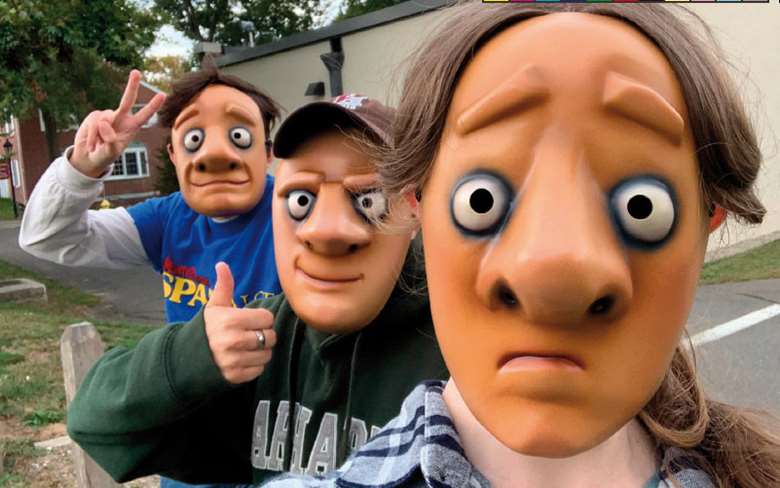Think inside the box: In-person theatre during Covid
Michael Calderone
Wednesday, February 10, 2021
When the pandemic hit, Connecticut drama instructor Michael Calderone had an idea that enabled his students to incorporate full-face coverings into a performance. He explains how he did it.

I am what can faithfully be described as a low-tech drama instructor. At Hopkins, the small independent day school in southern Connecticut where I teach, I pride myself on shows done simply: I prefer as few lighting cues as possible; live sound effects over recorded; I even teach an ensemble class that utilises living tableau rather than constructed scenery.
Yet, when COVID-19 hit, we were all confined to our homes, connected by webcam technology, and forced to produce our spring show as a podcast instead of a live performance. My graduating seniors had their final production, but sadly it was not ‘on stage’.
Full-face masks
Like many drama educators, I spent much of the following summer hemming and hawing about what our fall production could look like faced with the surmounting health restrictions: students six feet (two meters) apart; a small number of people allowed in the same room; and PPE to be worn at all times.
Normally, summers are the time when my mind wanders to the Edinburgh Festival Fringe, yet while wondering if we could attend next year, it reminded me of the full-face mask productions we saw in 2017. As it turns out, producing a full-face character mask show would not only tick off many safety protocols, but it would also give my students an opportunity to learn about this fascinating and often overlooked performance style.
Help from afar
While the production companies we saw at the Fringe were unreachable, Vamos Theatre in Worcester, England, proved incredibly helpful in our endeavors. Their comprehensive website included well-made videos of their productions, offered student workshops, and even mentioned tutorials on how to make our own masks.
Honor Hoskins, the company's creative producer and Youth Theatre director, walked me through every step of developing a performance. She generated a supply list for making masks, outlined mask acting workshops, and pointed us in the right direction, even if it meant steering us away from what Vamos Theatre could provide. When they could not supply us with the masks we needed, Honor gave me the contact information of the mask manufacturers they use – Strangeface Masks in Royal Tunbridge Wells – where I found exactly what I needed.
Life in quarantine
The script we used needed to be simple yet poignant, so I decided to float a questionnaire to the Hopkins student body about their experiences in quarantine. The questions ranged from politics, to the pandemic, to the mundane. Students complained about the four walls within which they were confined. They mentioned getting supplies, groceries and small purchases delivered in cardboard boxes. They bemoaned having to be taught through Zoom squares instead of being on campus. I realised then we had the theme and title of our show: Boxes.
From their personal stories, I was able to cobble together seven different vignettes, each scene containing between one to four actors. This allowed me to rehearse them in small groups who were able to maintain social distancing.
One of my favorite scenes came from an anonymous student who fell in love during summer camp but was separated from her sweetheart come September. She described a care package she received, writing, ‘He sent me a surprise in the mail with a sweatshirt of his … and a handwritten letter with 100 reasons why he misses me.’ Combining this lovely memory with social media accounts of ‘Zoom dates’, I wrote our scene titled ‘Camp Love’. In it, the two young lovers try to have a virtual date while being constantly interrupted by her mother and his college roommate. This vignette checked all my boxes!
Boxed in
Our set was simple. The stage was split into thirds and each third contained a hollow eight foot cube. The cubes were made of thin plastic pipes (PVC) connected at the corners with plastic joints. Each PVC cube area was outfitted with various wooden rehearsal boxes and a free-standing door unit. The PVC cube represented rooms in the characters’ houses and the rehearsal boxes were arranged to satisfy any furniture needs.
The crowning moment of the rehearsal process was the live, virtual workshop conducted by the Vamos Theatre artistic director Rachael Savage, Honor Hoskins, and their tech guru Daniel Hill. For two hours, Rachel and Honor worked virtually with my cast; first together and then by individual vignette. Technology did not get in the way of their keen eyes and spot-on suggestions on how my actors could improve.
Silver lining
Unfortunately, due to Covid's second wave, the world premiere of Boxes is currently on hold; however, time was not lost. My students were exposed to a beautiful and useful theatrical art form they may never have come across had the restrictions not been in place. Additionally, I would not have met the amazing people at Vamos Theatre. Someday, with these dreaded PPE masks off, we will be able to get together and play with the masks of our choosing. In the meantime, consider mask work for your kids if you find yourself boxed in.

